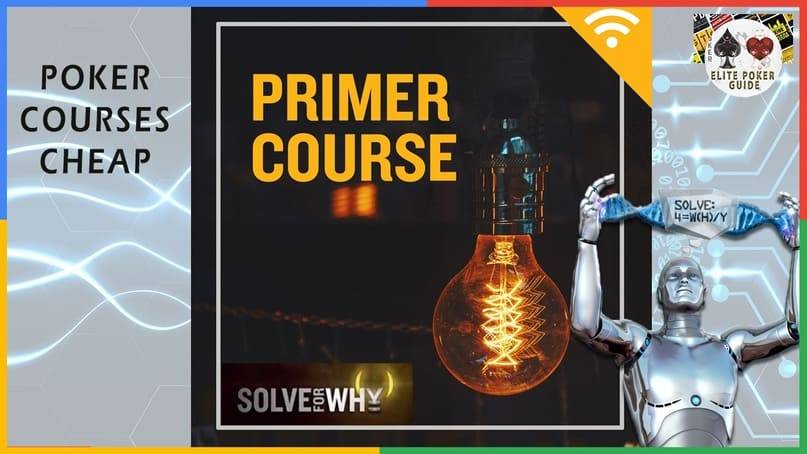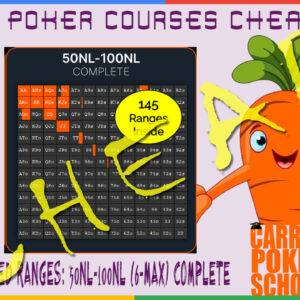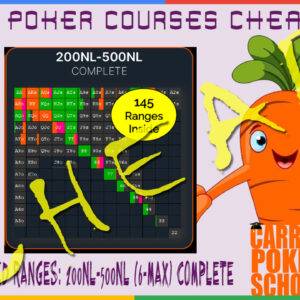What is Solve For Why The Primer Course for Cheap?
A 20+ hour course meant to lay the theoretical groundwork necessary to construct a holistic, winning poker strategy, with an emphasis on the mathematical elements of the game.
 SAMPLE: https://ok.ru/video/2561782778513
SAMPLE: https://ok.ru/video/2561782778513
Lesson 1a – Afforded Information & Key Terminologies
This lesson will set the stage for the course, and discuss the foundational information we have available to us in each hand we play, as well as introducing terms and concepts that will frame our discussions moving forward.
Topics covered:
- Primer course introduction
- What do we know?
- Range descriptors
- Strategic descriptors
- Betting descriptors
Lesson 1b – Math
This lesson will refresh your memory on some of the most fundamental mathematical realities of poker, while also introducing key concepts in game theory.
Topics covered:
- Expected Value
- Pot odds
- Game Theory
Lesson 2 – Equity
This lesson will explore the concept of equity in great detail, helping us to deepen our understanding of the mechanics of a hand of poker.
Topics covered:
- The nature of equity
- Range advantages
- Board textures
- The five key equity concepts (Realization, Capitalization, Retention, Denial, Fold Equity)
- Equity distributions
Lesson 3 – Preflop Dynamics
This lesson will unpack preflop play, dealing with issues of range construction and hand selection, featuring several example hands.
Topics covered:
- Constructing PFR ranges
- Range interdependence
- Flatting vs 3-betting
- Defending the Blinds
- The effects of SPR (Stack-to-Pot Ratio)
Lesson 4 – Balance
This lesson will explore the concept of balance, relating primarily to postflop play and featuring several example hands. It will form the foundation of many of our postflop discussions.
Topics covered:
- What is balance?
- When and why do we need it?
- Building balanced ranges (street-by-street)
- Effects of SPR
Lesson 5 – Bet Sizing
This lesson builds on the previous sessions discussions of balance, to discuss how issues of balance might affect our bet sizing choices. It will incorporate many concepts previously addressed in earlier lessons.
Topics covered:
- The polarization principle
- Preflop sizing
- C-betting and barrelling
- Range splitting
- Overbetting
- Effects of SPR
Lesson 6 – Narrowing Villain’s Range
This lesson will see us diving into four specific hand examples in-depth, to help shine a light on the process by which we narrow down an opponent’s hand range as the streets progress. We will also tackle the effects of SPR in each case.
Topics covered:
- MP vs BTN, single raised pot
- BTN vs BB, single raised pot
- BTN vs MP, 3-bet pot
- SB vs BTN, 3-bet pot
Lesson 7 – Narrowing Our Own Range
This lesson will see us looking at the example situations used in lesson seven, but this time from the opponent’s perspective. We’ll analyze our own ranges in these spots and examine how our strategy might look to an observer. We’ll also be looking at SPR considerations, as before.
Topics covered:
- MP vs BTN, single raised pot
- BTN vs BB, single raised pot
- BTN vs MP, 3-bet pot
- SB vs BTN, 3-bet pot
Lesson 8 – 3-bet Pots & Leverage
This lesson will see us delve into the dynamics of 3-bet pots, and explore how we can use psychological and technical leverage to force our opponents into difficult spots, as well as focusing on how to adapt when changes to SPR force a change in our strategy.
Topics covered:
- What is leverage?
- C-betting vs realization
- Merged vs poled situations
- Effects of SPR
Lesson 9 – Opponent Profiling
This lesson will wrap up the course by examining the types of opponents we most commonly face, and identifying simple exploitative strategies for adapting to common population tendencies and weaknesses. It will also wrap up the course as a whole, and set your expectations for your Academy experience.
Topics covered:
- Population tendencies
- Building a profile
- Opponent archetypes
- Primer course wrap-up
Lesson 10 – Optimization
In this lesson, we’ll wrap up the Primer Course by detailing how we can add simplifications to our strategy in certain spots to improve efficiency, while also exploring areas where adding complexity can give us a bigger edge.
Topics covered:
- Simplifying complex situations
- Adding complexity
- S4Y Academy preview
💬 Feel free to reach out to our CHAT support for personalized assistance and detailed information tailored to your needs. We’re here to help!








Reviews
There are no reviews yet.